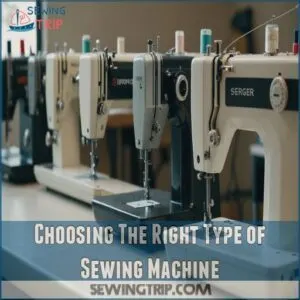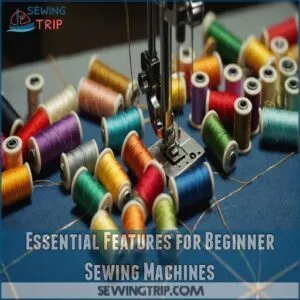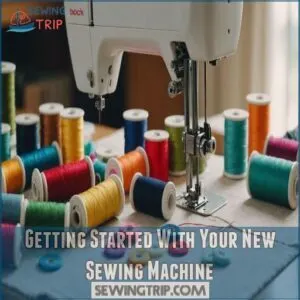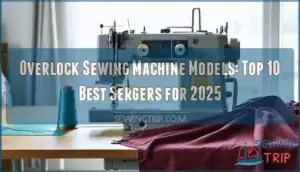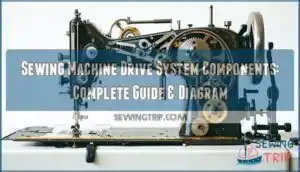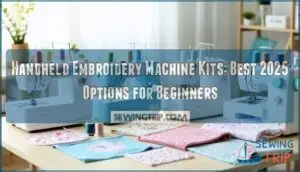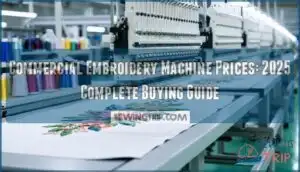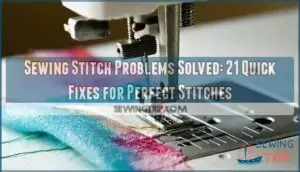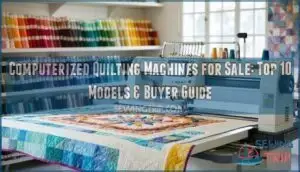This site is supported by our readers. We may earn a commission, at no cost to you, if you purchase through links.
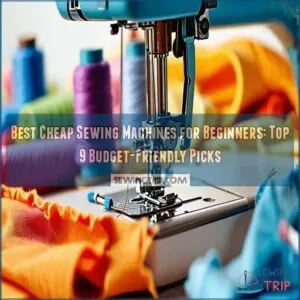 You’ll find fantastic options for best cheap sewing machines for beginners that won’t break the bank.
You’ll find fantastic options for best cheap sewing machines for beginners that won’t break the bank.
The Singer Heavy Duty stands out with 97 stitch applications and a motor that can handle thick fabrics – perfect for when you’re ready to tackle those DIY jeans repairs!
For true newbies, the Singer 2250 Tradition offers 10 essential stitches and a four-step buttonhole, letting you master the basics without getting overwhelmed by bells and whistles.
Brother’s XR3774 strikes a sweet spot with 37 built-in stitches and a one-step buttonhole – think of it as training wheels that grow with you.
Stay tuned for insider tips on choosing between mechanical and computerized machines.
Table Of Contents
- Key Takeaways
- Top 9 Cheap Sewing Machines for Beginners
- 1. Singer Heavy Duty Sewing Machine
- 2. Singer 8280 Sewing Machine
- 3. Singer 2250 Tradition Basic Sewing Machine
- 4. Brother XR3774 Sewing and Quilting Machine
- 5. Brother CS7000X Sewing and Quilting Machine
- 6. Brother SE700 Embroidery Sewing Machine
- 7. Janome 3160QDC G Sewing Quilting Machine
- 8. Juki TL 2010Q Sewing Quilting Machine
- 9. Portable Sewing Machine for Mending
- Choosing The Right Type of Sewing Machine
- Essential Features for Beginner Sewing Machines
- Getting Started With Your New Sewing Machine
- Frequently Asked Questions (FAQs)
- Conclusion
Key Takeaways
- You’ll find reliable options like the Singer Heavy Duty and Brother XR3774 that offer essential features without breaking the bank, perfect for mastering basic techniques.
- Consider whether you need a full-size machine for serious projects or a mini for basic tasks, and weigh the pros and cons of computerized vs. mechanical models based on your needs and budget.
- Look for beginner-friendly features like automatic needle threaders, one-step buttonholes, and quick-set bobbins to make your sewing experience smoother and more enjoyable.
- Start with simple projects, join local sewing classes or communities, and practice regularly to improve your skills and make the most of your new machine.
Top 9 Cheap Sewing Machines for Beginners
You’re about to discover nine budget-friendly sewing machines that won’t break the bank but will still give your creative projects a professional edge.
From sturdy workhorses to feature-packed marvels, these machines are perfect for beginners who want to start stitching without emptying their wallets.
1. Singer Heavy Duty Sewing Machine
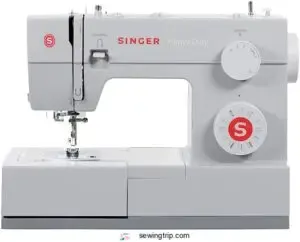
When you’re ready to get started with sewing, the Singer Heavy Duty machine is a workhorse that’ll have you stitching up a storm.
With 97 stitch applications and a zippy 1,100 stitches per minute, you’ll breeze through projects faster than you can say "bobbin."
Its muscle comes from a beefed-up motor, perfect for tackling thick fabrics without breaking a sweat.
The automatic needle threader is a real eye-saver, and the LED lighting makes sure you won’t be left in the dark.
Just remember to practice with the foot control – it’s got a bit of a lead foot!
Best For: The Singer Heavy Duty sewing machine is best for those who sew with heavy fabrics and need a machine that can handle a lot of layers.
- 97 stitch applications for a variety of sewing needs.
- Strong motor for handling thick fabrics.
- Automatic needle threader and LED lighting make sewing easier.
- Some users have reported issues with thread tension and bobbin jams.
- The foot control can be difficult to manage for fine control.
- The manual is not comprehensive.
2. Singer 8280 Sewing Machine
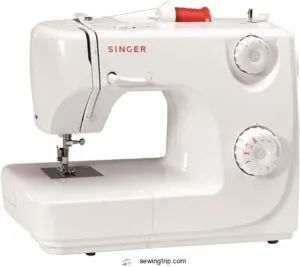
Looking for a sewing machine that won’t break the bank?
The Singer 8280 might be your new best friend.
This lightweight wonder packs a punch with 66 stitch applications and a durable metal frame.
You’ll love the easy threading and adjustable presser foot pressure.
It’s like having a mini tailor in your home!
With a free arm for tricky hems and a built-in storage compartment, you’ll feel like a pro in no time.
Just keep in mind, some users have reported minor hiccups, so handle with care.
Happy stitching!
Best For: The Singer 8280 is best for beginners and casual sewers who need a versatile machine with a decent amount of features.
- Easy to use with features like quick threading and adjustable presser foot pressure.
- Durable metal frame and lightweight design make it easy to move and store.
- Offers a variety of stitch applications for different sewing needs.
- Some users have reported issues with the product arriving broken or defective.
- The machine may have a slight imbalance in the wheel that turns when sewing.
- May not be as robust as other sewing machines.
3. Singer 2250 Tradition Basic Sewing Machine
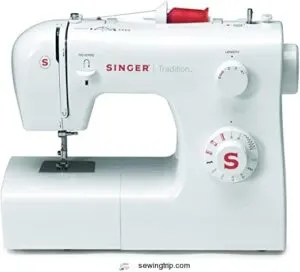
The Singer 2250 Tradition Basic Sewing Machine is a great example of an inexpensive sewing machine that offers numerous beginner-friendly features, including an automatic needle threader for beginners, making it a no-frills workhorse for beginners.
You’ll find threading a breeze and stitch selection straightforward.
With 10 built-in stitches and a four-step buttonhole, you’ve got the basics covered.
Adjust stitch length and zigzag width to your heart’s content.
Just keep in mind, it’s designed for US and Canadian voltage.
Some users have hit snags with durability and the manual’s clarity.
The threading process might test your patience, and the needle can be a bit of a thread-dropper.
But hey, for a budget-friendly start, it’s worth a spin!
Best For: This is a great option for beginners who want a basic machine without breaking the bank.
- Easy threading and stitch selection
- Versatile with 10 built-in stitches and a four-step buttonhole
- Adjustable stitch length and zigzag width
- Some users have reported quality and durability issues
- The instruction manual can be difficult to understand
- The threading process can be less intuitive than other machines
4. Brother XR3774 Sewing and Quilting Machine
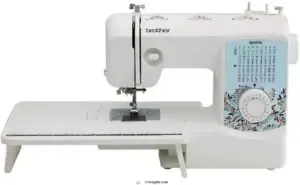
Get started with sewing and quilting with the Brother XR3774, a versatile machine that won’t break the bank.
You’ll find 37 built-in stitches, including decorative and quilting options, plus a one-step buttonhole.
The automatic needle threader saves you squinting, while the drop-in bobbin keeps things simple.
If you’re looking for more affordable options like this, check out other cheap sewing machines online.
It’s like having a sewing buddy that comes with all the bells and whistles – a wide table, 8 feet, and even an instructional DVD.
Just remember, it might struggle with thick layers of fleece, but it’ll breeze through most projects like a champ.
Best For: Beginners and those seeking a budget-friendly option for quilting and general sewing projects.
- Easy to use with a variety of built-in stitches.
- Includes a wide table and helpful accessories for quilting.
- Affordable price point.
- May struggle with thicker fabrics.
- Can be noisy and vibrate when sewing quickly.
- Automatic needle threader can be finicky.
5. Brother CS7000X Sewing and Quilting Machine
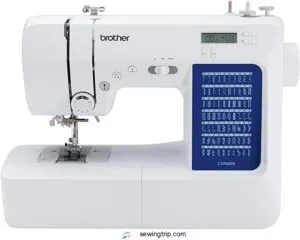
For beginners with big dreams, the Brother CS7000X is a real gem.
You’ll love its 70 built-in stitches and 7 one-step buttonholes, giving you room to grow.
The automatic needle threader is a lifesaver, especially when you’re just starting out.
Its large workspace is perfect for quilting projects, and the durable metal frame means it’ll stick with you through thick and thin.
Plus, with a 25-year warranty, it’s like having a sewing buddy for life.
Just remember, good thread is key to avoiding tension headaches!
Best For: Beginners and those looking for a versatile machine with a range of features.
- Easy to use with features like an automatic needle threader and large workspace.
- Offers a wide variety of stitches and features for various sewing and quilting projects.
- Comes with a 25-year warranty for long-lasting peace of mind.
- Some may find the built-in LED lighting insufficient.
- Requires using good quality thread to avoid tension issues.
- Designed for 120 volts (US only).
6. Brother SE700 Embroidery Sewing Machine
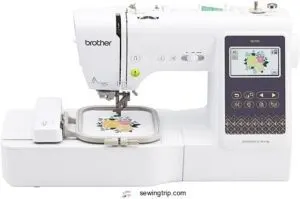
While the Brother SE700 might seem like overkill for beginners, it’s a game-changer if you’re eyeing embroidery.
This 2-in-1 machine lets you sew and embroider, giving you room to grow.
You’ll love the wireless connectivity and Artspira app for easy design transfers.
With 135 built-in designs and 103 stitches, you’ve got plenty to play with.
The large touchscreen and auto-threader make life easier, but heads up – some users found the tension tricky and connecting to the app frustrating.
Still, if you’re dreaming big, this machine’s got your back.
Best For: The Brother SE700 is best for those who want a powerful and versatile sewing and embroidery machine with wireless connectivity and a user-friendly touchscreen.
- Wireless connectivity for easy design transfer
- Large touchscreen for intuitive navigation
- Auto-threader and automatic thread cutter for convenience
- Some users found the tension to be off
- Difficulty connecting to the Artspira app
- Limited design availability
7. Janome 3160QDC G Sewing Quilting Machine
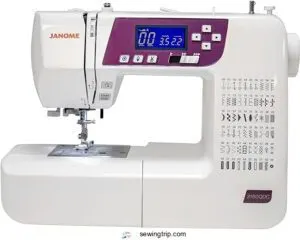
The mint-colored Janome 3160QDC G is your ticket to quilting paradise.
You’ll love its 60 built-in stitches, including 6 one-step buttonholes, and the Superior Plus Feed System that handles any fabric like a dream.
At just 12 pounds, you can easily take this powerhouse to quilting classes.
The automatic thread cutter and built-in needle threader save you time, while the included extension table gives you plenty of space to spread out.
Though it’s a bit pricey at $999, you’re getting a feature-packed machine that’ll grow with your skills.
Best For: This machine is perfect for quilters of all levels, from beginners to experienced sewers.
- Easy to use and set up
- Portable and lightweight
- Durable and well-built
- Some users have reported issues with thread jamming and the automatic threader not working properly.
- The price point may be a consideration for some buyers.
- The machine can be a bit noisy.
8. Juki TL 2010Q Sewing Quilting Machine
Serious quilters, you’ll love this powerhouse! Juki’s TL 2010Q, weighing in at 39 lbs, isn’t just a sewing machine—it’s your ticket to quilting nirvana.
With its lightning-fast stitching, whisper-quiet operation, and heavy-duty build, you’ll breeze through projects like a pro.
The automatic thread cutter and knee lifter are game-changers, letting you focus on your creativity.
Sure, threading can be tricky at first, and the manual might leave you scratching your head, but don’t let that stop you.
Once you’ve mastered the learning curve, this reliable workhorse will become your new best friend in the sewing room.
Best For: Serious quilters who want a powerful and reliable machine.
- Lightning-fast stitching
- Whisper-quiet operation
- Heavy-duty build
- Threading can be tricky
- Manual is not clear or concise
- Customer service is poor
9. Portable Sewing Machine for Mending
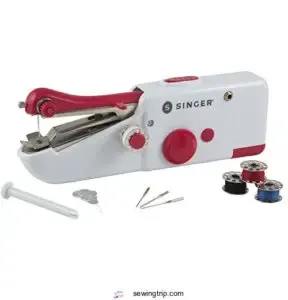
Looking for a quick-fix sidekick?
Singer’s handheld portable mending machine might be your go-to for emergency repairs.
It’s perfect when you need to tackle a fallen hem or loose seam on the fly.
You’ll get threads, bobbins, and needles included, but don’t forget to grab some batteries!
Keep in mind, this little helper works best with lightweight fabrics and isn’t meant to replace your regular sewing machine.
Think of it as your trusty backup dancer – great for simple moves but not ready for the main performance.
Just remember, it can be a bit finicky to control and the battery life isn’t stellar.
Best For: This portable mending machine is best for people who need a quick and easy way to fix small tears or hems on lightweight fabrics.
- Compact and lightweight for easy portability.
- Includes all the essentials like needles, thread, and bobbins.
- Perfect for simple repairs on lightweight fabrics.
- Battery life is short.
- Can be difficult to control due to lack of speed settings.
- Limited to two layers of fabric thickness.
Choosing The Right Type of Sewing Machine
You’ll need to pick between full-size machines for serious projects and mini ones for basic tasks, just like choosing between a sports car and a compact for your daily commute.
You’ll find options that won’t break the bank while meeting your sewing needs.
Whether you go for a computerized model with fancy features or stick to a trusty mechanical workhorse, you’ll find options that won’t break the bank while meeting your sewing needs.
Full-size Vs. Miniature Sewing Machine
Now that you’ve got an idea of what’s out there, let’s tackle a common head-scratcher: should you go full-size or mini?
Space-savvy sewists might be tempted by cute mini machines, but don’t let their compact charm fool you!
If you’re just starting out, check out beginner-friendly resources like a beginner sewing machine guide for more info.
Full-size machines offer stability and room to grow your skills.
Mini machines can be perfect for quick fixes and tight spaces.
Consider your project types – quilts need more workspace.
Your budget matters, but don’t sacrifice quality for portability.
Computerized Vs. Mechanical Sewing Machine
While you’re exploring sewing machine options, let’s talk tech!
Computerized sewing machines offer fancy bells and whistles like LCD screens and pre-programmed stitches, but they’ll cost you more.
Mechanical machines, like the best mechanical sewing machines for beginners, are your budget-friendly workhorses that allow you to learn the fundamentals without getting overwhelmed.
Think of it like choosing between a smartphone and a flip phone – both make calls, but one’s got extra features you mightn’t need yet.
Serger Sewing Machine for Beginners
A serger can feel like your secret weapon for professional-looking seams.
Unlike standard sewing machines, sergers trim fabric edges and wrap them in thread simultaneously, creating that coveted overlock stitch.
You’ll love how quickly it finishes edges and prevents fraying – think store-bought clothing quality!
For beginners, start with a basic 3/4 thread serger.
It’s perfect for most Serger projects and won’t overwhelm you with features.
Essential Features for Beginner Sewing Machines
You’ll need a few key features to make your first sewing experience less like wrestling an octopus and more like gliding through fabric.
With the right automatic needle threader, one-step buttonhole feature, easy bobbin setup, and essential presser feet, you’ll be ready to tackle any beginner-friendly project that comes your way.
Automatic Needle Threader and One-Step Buttonhole
Say goodbye to squinting and fumbling with thread!
An automatic needle threader can be a total game-changer, especially after a long day when your eyes are tired.
You’ll also love having a one-step buttonhole feature – it’s like having a tiny tailor inside your machine.
Just pop in your button, and the machine measures and creates a perfect buttonhole to match.
These features turn frustrating tasks into simple, satisfying wins.
Quick-Set Bobbin and Stitch Selection
Threading can be tricky, but let’s talk about another game-changer: the quick-set bobbin system. You’ll feel like a sewing superhero when you pop in a bobbin and it’s ready to go – no more wrestling with tension or timing! Plus, having various stitch options at your fingertips lets you tackle any project with confidence.
- Drop-in bobbins are foolproof – just drop, click, and you’re good to go
- Most beginner machines offer 10-30 built-in stitches for versatility
- Adjustable stitch length gives you control over your seam appearance
- Clear bobbin covers let you monitor your thread supply – no mid-seam surprises!
Presser Feet and Extension Table
Now that you’ve got your stitches sorted, let’s talk about the tools that’ll make your sewing life a breeze.
Different presser feet and a handy extension table can transform your sewing game from frustrating to fantastic.
Here’s a quick rundown of what you’ll need:
| Foot Type | What It Does For You |
|---|---|
| All-Purpose | Your daily driver for straight stitches |
| Zipper | Makes adding zippers less of a headache |
| Buttonhole | Creates perfect buttonholes every time |
| Walking | Keeps layers from shifting as you sew |
| Blind Hem | Creates invisible hems like a pro |
Getting Started With Your New Sewing Machine
You’ll feel more confident with your new sewing machine if you take the time to learn its features and practice basic techniques.
Whether you decide to join a local sewing class or learn from online tutorials, it’s important to start with simple projects that help you get familiar with threading, adjusting tension, and using different stitches.
Local Sewing Classes and Communities
Why tackle your sewing journey alone when there’s a whole community ready to welcome you?
Local sewing classes offer invaluable hands-on guidance, while connecting you with fellow fabric enthusiasts.
You can also find online resources and shops that specialize in beginner sewing machines, such as beginner sewing machines online.
Here’s what you’ll find in your local sewing community:
- Expert instructors who’ll help you master your machine’s features
- Group projects that turn learning into social fun
- Regular meetups where you can swap tips and show off your creations
Plus, many fabric shops host free demos – perfect for test-driving different machines!
Tips for Practicing and Improving Sewing Skills
Getting your hands on a sewing machine opens up a world of creative possibilities.
Let’s start with some practical steps to boost your skills.
Start with simple projects and gradually work your way up to more complex ones.
Familiarize yourself with the key components of your sewing machine, including the needle, presser foot, and tension dial settings.
Here’s a handy guide to help you progress:
| Skill Level | Project Ideas | Practice Tips |
|---|---|---|
| Beginner | Straight line stitching | Use paper guides |
| Basic | Simple tote bags | Test tension settings |
| Intermediate | Zippered pouches | Try different fabrics |
| Advanced | Basic clothing | Master buttonholes |
| Expert | Quilting projects | Experiment with decorative stitches |
Remember, every sewing whiz started as a newbie.
Take your time, enjoy the learning process, and don’t be afraid to make mistakes – they’re your best teachers!
Frequently Asked Questions (FAQs)
Are cheap sewing machines good for beginners?
Budget-friendly sewing machines can be perfect for beginners!
You’ll get essential features without breaking the bank.
Start with reliable brands like Brother or Singer – they’ll help you master the basics before upgrading.
What is the best beginner sewing machine?
The Brother CS7000X stands out as your ideal first machine, offering 70 stitch options and an automatic buttonhole feature. You’ll appreciate its user-friendly LCD screen and reliable top-loading bobbin system.
What are the best sewing machines for a budget?
You’ll find great value in Brother GX37 with 37 built-in stitches and Singer Start 1304 for basic needs.
Brother CS5055 offers advanced features while staying affordable.
They’re reliable machines that won’t break your bank.
What can I do with a sewing machine if I’m a beginner?
Ready to tap into your creative potential?
Start with simple projects like hemming pants or making pillowcases.
Then progress to crafting tote bags and basic clothing repairs.
You’ll master essential skills while building confidence.
What is the easiest sewing machine to use for a beginner?
Start your sewing journey with Brother CS7000X – it’s user-friendly with automatic threading, clear LCD display, and 70 built-in stitches.
You’ll love its intuitive controls and helpful features for mastering basic techniques.
Is it worth buying a cheap sewing machine?
Budget-friendly sewing machines like the Singer 8280, which offers 7 built-in stitches and a free arm in a budget-friendly model Singer 8280 review, or Brother GX37 or Singer Start 1304 can serve you well.
They’ll help master basic techniques without breaking the bank.
Though you might outgrow their limited features as your skills advance.
How much should a beginner spend on a sewing machine?
When starting out with sewing, it’s essential to consider the Best Cheap Sewing Machines Reviewed to find the perfect machine for your needs. You’ll get great value spending between $150-$300 on your first sewing machine.
This range offers reliable options like the Brother CS7000X or Singer 7258, which include essential features for building your skills.
Which sewing machine has the least problems?
Want a worry-free sewing experience?
Brother CS7000X and Janome Blue Couture consistently rank highest for reliability.
They’re built with metal frames, have fewer mechanical parts to break, and come with solid warranties.
How long does a cheap sewing machine last?
When shopping for a budget sewing machine, considering the type of projects you’ll be working on and the features you need is crucial, such as checking the included presser feet like zigzag and blind hem feet. A well-maintained cheap sewing machine typically lasts 3-5 years with regular home use.
You’ll extend its lifespan by keeping it clean, oiled, and serviced annually, just like caring for a trusty car.
Can cheap sewing machines handle denim or leather?
Like Sarah’s Singer Heavy Duty 4411, basic affordable machines can tackle denim, but you’ll need specific needles.
For leather, consider upgrading to a sturdier model with adjustable presser foot pressure and stronger motor.
Whats the difference in noise between models?
Noise levels can vary a great deal between sewing machine models, with some like the Singer M1500 offering a quieter experience for home sewing needs. Noise levels can vary a great deal between sewing machine models.
Mechanical machines tend to be louder than computerized ones.
Higher-end models often have better insulation and quieter motors.
Consider testing machines in-store to compare their noise levels firsthand.
Are spare parts available for budget machines?
Spare parts for budget machines can be a bit of a mixed bag.
You’ll find common replacements like needles and bobbins easily, but specialized components might be trickier.
It’s worth checking the manufacturer’s website for availability.
Do cheap machines need more frequent maintenance?
Cheap machines don’t necessarily need more frequent maintenance, but they might.
You’ll want to keep them clean and oiled regularly.
Treat ’em right, and they’ll serve you well.
Just like a trusty old car, a little TLC goes a long way.
Conclusion
You’ve just discovered the secret to sewing success without breaking the bank!
These best cheap sewing machines for beginners are your ticket to stitching stardom.
Remember, it’s not about having every bell and whistle – it’s about finding the right fit for your needs and budget.
Whether you’re mending clothes or crafting quilts, there’s a machine here that’ll have you sewing circles around your wildest dreams.
So grab your fabric, thread that needle, and let’s turn those Pinterest boards into reality!
- https://www.sewingmachinefun.com/best-cheap-sewing-machines/
- https://www.thespruce.com/best-beginner-sewing-machines-to-buy-4137153
- https://www.goodhousekeeping.com/home-products/g27760473/best-sewing-machines-for-beginners/
- https://www.bhg.com/best-sewing-machines-for-beginners-7479688
- https://sewing-beginners.com/best-cheap-sewing-machines/

